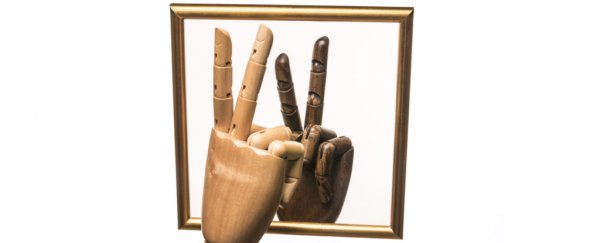A new spin on a classic sensory illusion is revealing more details on how our body combines sensations to model the body in our mind.
Using a mirror to fool the brain into confusing a reflected hand for the hidden one isn't new to either amateur magicians or neurologists, but by making one of the hands rotate researchers have discovered how muscle tension contributes to our mental map of self.
University of Delaware scientist Jared Medina and his doctoral student Yuqi Liu turned to the favourite party trick to study how the mind combines stimuli to construct our sense of proprioception – the relative arrangement of body positions in our mental space.
Devised by two Princeton researchers in the late 1990s, the mirror box illusion is traditionally done with two hands placed flat on a surface in front of a subject, where one is hidden behind a mirror.
The free hand is reversed in the reflection, seeming to occupy the same space as its partner. Visually speaking, the brain accepts the reflection as the hidden hand.
Replacing the visible limb with a dummy version and stroking it while touching the fingers of the hidden hand can produce an eerie sensation for many people, one where the brain seems to feel the fake hand.
Fun and games aside, for neurologists this has become an immensely useful tool for analysing the workings of the brain when it comes to combining visual and tactile stimuli into a sense of body space and ownership.
The mirror box also has a therapeutic benefit for individuals suffering from discomfort in their phantom limbs; body parts that are no longer present, but still occupy neurological real estate that can be stimulated to sense pain or irritation.
Usually, the highly precise nature of our visual system means it gets to take priority when it comes to locating our body parts, allowing therapists to overwrite the brain's assumptions.
"Vision, because it is more precise, typically rules," says Medina.
"However, in our study, the brain also appears to be considering additional information – biomechanical constraints from the body schema – in resolving this conflict between the senses."
Medina and Liu wanted to know how the brain dealt with a battle between what the eyes see and what the muscles feel in determining how our hands moved in our mind.
Previous rubber-hand experiments had suggested that there was a relationship between the strength of the odd sensation and how closely the position of the hidden hand matched its reflected double.
This made it clear that if there was enough of a difference between what the eyes saw and the strain reported by the muscles, the brain would quickly lose trust in the visual stimuli.
But what if the muscles were straining, but also moving in a way that backed up the visual report?
Medina and Liu's version of the mirror box illusion involved 24 volunteers in three different experiments, each requiring participants to have hands rotated into contrasting positions on either side of the mirror.
With one hand palm up and the other palm down, the volunteers were asked to open and close both hands.
"All of a sudden during our experiments, you'd hear a little laugh of surprise when people experienced this neat sensation of feeling like their hand flipped, even though it did not move," says Medina.
Each experiment then examined the effect of placing the hidden hand into different positions behind the mirror.
The relative angles of the hand placed restrictions on how easily the hand could be opened and closed, providing important mechanical feedback for the brain.
Based on the participant's reports, it appears that as it gets harder to open and close the hidden hand in a manner that matches the reflection, the harder it gets to achieve the illusion. Our brain is able to override what the eye sees because of what our body is feeling.
It's a small discovery, but contributes to our growing understanding of how our mind weaves together a range of sensations to develop a complex understanding of our body's boundaries and positioning in time and space.
This research was published in Scientific Reports.
